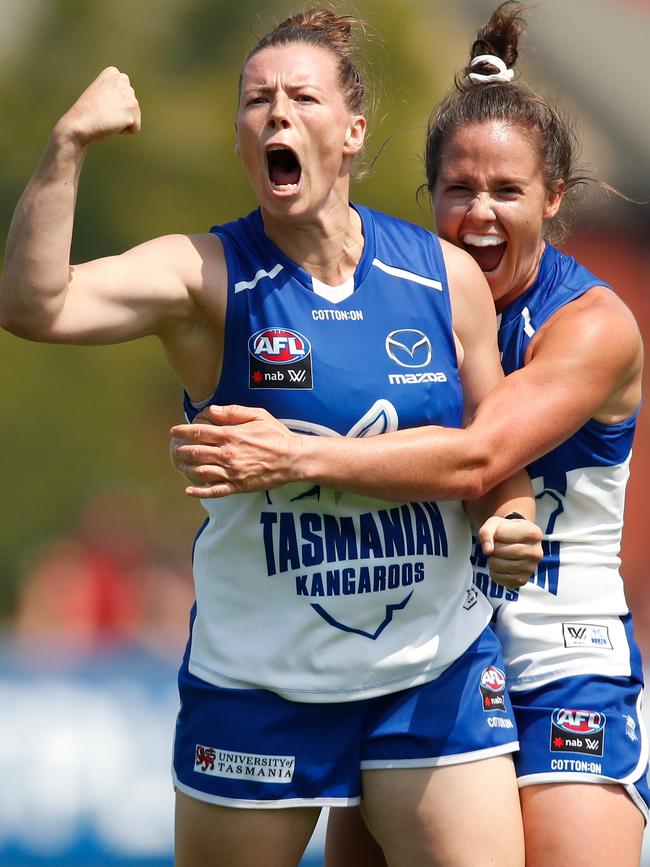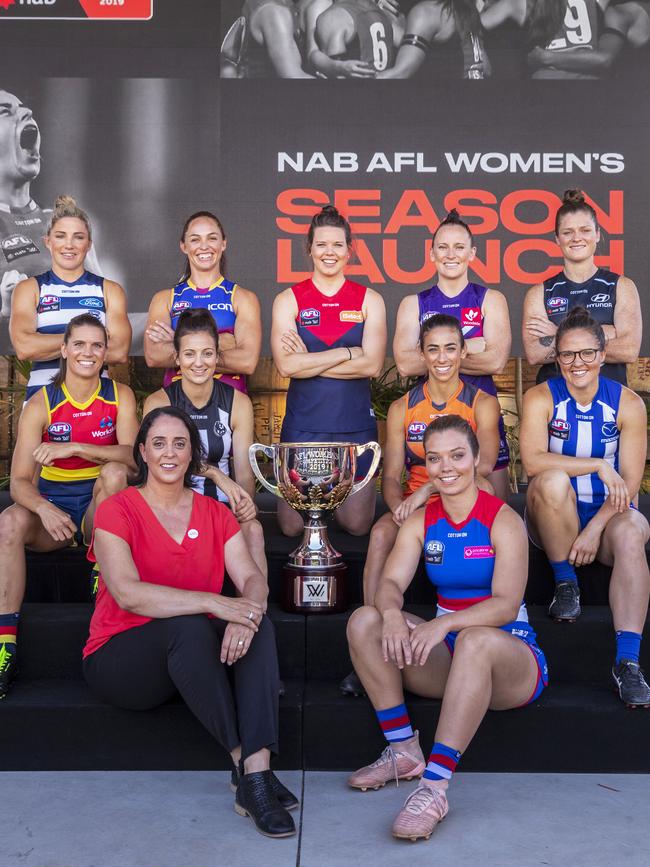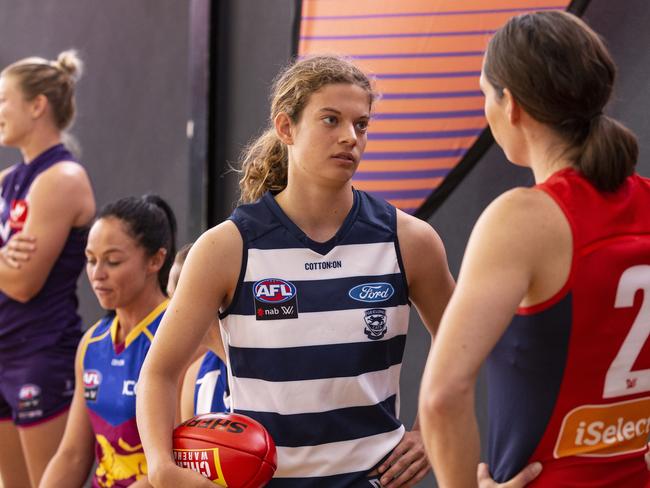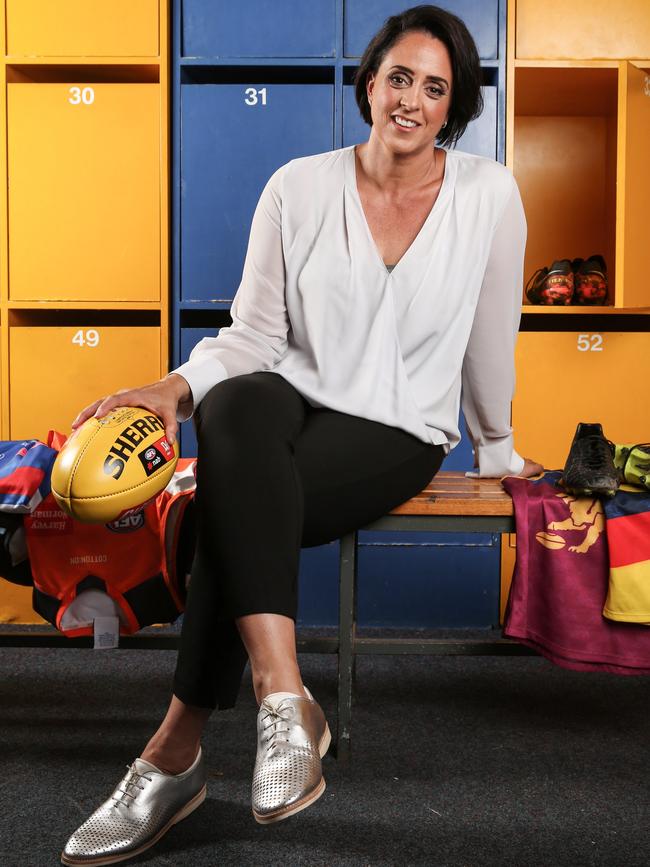The end game: AFLW boss Nicole Livingstone on ACLs and rule changes and when we might see a Port Adelaide women’s team
In a far-reaching interview, AFLW boss Nicole Livingstone talks about rule changes, injuries concerns and when South Australians might see Port Adelaide field a women’s team
AFLW
Don't miss out on the headlines from AFLW. Followed categories will be added to My News.
- Port Adelaide is keen to field an AFLW team
- AFLW sticking by their controversial conference system
- Behind the scenes with the Crows AFLW side
This week, the AFLW was forced to defend its controversial conference system, after criticism about its lopsided nature, where the best five AFLW teams, including Adelaide, are all lumped together in Conference A. Putting that to one side, the AFL’s head of women’s football Nicole Livingstone sees plenty to like about season three of the burgeoning competition. She spoke with LIZ WALSH.
LW: What do you make of the standard of AFLW so far this season?
NL: We’re seeing an increase in scoring and some really tough battles to win a game.
Last weekend, we had all five winning teams score 50-plus points, which was fantastic. But we’re also seeing increased athleticism, we’re seeing the players skills really showcased.
We had 10 rules changes introduced in 2019 and a good rule change is one you don’t notice … and I think with the rules we’ve adopted that has been the case. Particularly the boundary throw-ins coming in 10m, which means the secondary stoppages aren’t going over the boundary. We’re seeing that reflected in the scoreline.
The quirks of the conference system aside, another question being asked is whether expansion club North Melbourne — currently sitting atop Conference A with a phenomenal percentage of 250.8, almost 100 points clear of second place — was allowed to be too good, too quickly. With four new teams — Gold Coast, Richmond, St Kilda, West Coast — slated to enter AFLW in 2020, what lessons are being learnt from that?
The 2020 lists will continue to be looked at. Obviously we have our 2020 expansion clubs that are able to sign some open age players and three underage players at the moment. They’ll start to take shape and some of the clubs have already announced signings, but it continues to be looked at.

We now have a competition committee as well, just like the men’s competition, and all of that does go through the competition committee … it’s an involved process. We don’t take any of this lightly and we do want to make sure we do make considered decisions.
Will we see all 18 AFL clubs with a women’s team by 2021?
We’ve got four teams slated for 2020, and the remaining teams — Hawthorn, Port Adelaide, Essendon, Sydney — are interested; Essendon and Hawthorn in particular and if we opened the door to them tomorrow they’d say yes.
But we need to make sure we do that in a sustainable manner. We have said publicly that our vision is to have all 18 clubs with a women’s team, because we think that is fair and just, not only for those who love football, but as an opportunity for women.
But when that takes place? I can’t tell you, because it’s about looking at the talent coming through. We would like to think about 2023 as potentially having all 18 clubs with a team, but again, that would have to be looked at as the competition moves along.
Will the conference system stay in an expanded AFLW?
It will be the competition committee that will make those decisions. One of the challenges for people who follow footy and love AFL is to have a different lens on and not saying constantly: ‘Well, we wouldn’t do that in the men’s’.
This is AFLW and we need to make this the strongest competition we can and it’s not just about trying to go to 23 home and away rounds, which is what I hear often.
It’s about thinking about our audience and attendance and trying to make it commercially sound. The end game is to try and have our female athletes able to choose to be full-time players and in year three of this competition, we continue to push forward to that.
With a 38 per cent pay increase for AFLW players this year we’re certainly on a course to figure out how to expedite the amount of time it took for the men’s game to get to that full time stage, which we think took about 35 years … and again making sure that it’s sustainable, it’s viable and that we don’t topple this over.

Will AFLW ever include ticketed games? And for us in SA, games at the Adelaide Oval?
When we’re in colliding timelines with cricket with wickets in surface, it’s a little bit difficult. But going to bigger venues is something we would like to explore and trial. We’re not going to shy away from being innovative.
This season, we are using Marvel Stadium and we’ve got a double header there (Collingwood v Nth Melbourne and Bulldogs v Melbourne on March 9) … but it’s a risk in a 53,000-capacity stadium. You look at the BBL grand final with two Victorian teams and they only got 40,000 who came through the door.
Will innovation ever include expanding beyond 18 clubs and moving into the Northern Territory, Tasmania and even New Zealand?
I heard about NZ the other day. I think we need to keep an eye on talent and what is sustainable. It is not cheap to run AFLW and right now, in terms of match costs and player costs, the AFL is paying for all of that and as we expand then obviously it is more expensive.
When we talk about the investment though, we’re not thinking about it being a drain, we’re actually thinking about it being an investment for the future.
And not only is it the right thing to do, to have females being able and allowed to play AFLW, but we also need to enable a competition that allows them to be the best athletes they can be. Right now, we’re at the short competition and I recognise the players want more, but we’re only in year three and we need to take care with it.
Is there an issue with concussion and ACL injuries?
I think females are predisposed to ACL injuries no matter what sport they play and so there are things we can’t change, like somebody’s genetic predisposition.
But we can make a difference when it comes to prehabilitation work. We’ve circulated to all our 14 clubs our program called Prepped to Play, which gives a lot of detail on a prehabilitation program the athletes can do and skills and drills coaches can do with their players in warm up. What we do know is that if they can commit to three-by-30-minutes of prehabilitation a week, it can reduce the likelihood of an ACL injury.

Women’s football has always been around but there certainly hasn’t been the structure, policy and procedure in behind it because of how quickly it’s grown. The National Female Football Guidelines will be released out into all 3200 community clubs this year in time for the community season … we’re taking (concussion) seriously. We’re looking at three areas in particular: the ground ball gets, how you give and take a tackle, and aerial contests, so how you jump into the air and how you land.
Should AFLW be compared with AFL?
I heard someone say that Cathy Freeman won the 400m at the Sydney Olympics in 2000, and we, as a nation, celebrated and revered that. But if you put Michael Johnson up against her, he would have beaten her by a considerable margin. Do we devalue Catherine’s race because Michael was faster than her? No.
Celebrating what we’re seeing in AFLW is really important and yes, our big brother does cast a shadow over us sometimes, but the AFL is very supportive of AFLW, financially supporting it and making sure it has a long term vision and that it is going to be successful.



